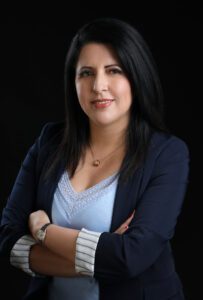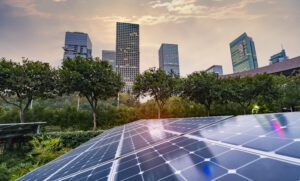In 2021, Schneider Electric was named the top sustainable enterprise in the world by Corporate Knights, an organization founded in 2005 to promote and encourage responsible and sustainable capitalism globally.
The award was the result of the company’s long and deep commitment to energy sustainability—and to the many individuals on the “frontline” who make it happen. Learn more in this press release from Schneider Electric.
As the VP of Strategy & Digital Energy for Middle East & Africa, I play a key role in Schneider Electric’s efforts to bring energy sustainability to this critical region of the world.

In this interview, I talk about why sustainable energy is so important, and why every enterprise and individual needs to help.
Q: What forces are pressuring enterprises toward greater sustainability? Do they really have a choice?
A: No, there is no choice. The cost is of not being sustainable is too high. First, it’s about the impact of climate change. We all are responsible to protect our planet. We have to limit global warming to 1.5 degrees Celsius. The worst-case scenario is at 3 degrees Celsius, and at the rate we’re going, we are projected to be around 2.5. So, we all have a responsibility as humans to protect our planet from global warming.
Then, sustainability is becoming increasingly a business imperative, due to monetary and regulatory pressure. For example, if you want to work with the IMF, or the World Bank, you have to be sustainable. In Ghana with a strong push for solar energy from the World Bank and the International Finance Corporation, life for thousands of Ghanaians is beginning to change. The $220 million Ghana Energy and Development Access Project (GEDAP) is among the first Bank-financed programs to focus on inclusive access to renewable energy through off-grid solar services and products and this is supporting Ghana goal of increasing the weight of renewable energy by 10% in the national energy mix by 2030 focusing on solar Microgrids.
Then, there is also the civil pressure. Consumers are more aware, and they trend toward sustainable production. In universities, for example, there is pressure to be sustainable in order to attract the best students. It is seen as a competitive advantage to appeal to the best and brightest of a new generation of leaders. The same for companies, having a meaningful purpose is key to attract talents.
Q: How do we go about tackling such a big challenge?
A: We believe that electrification and digitization is the recipe of sustainable and resilient world. We call this “Electricity 4.0”.
Electricity is the best vector for decarbonization because it is the greenest source of energy by a factor of 3-5. We expect 6 times more electricity coming from renewables by 2040.
Digital makes energy smart. It makes the invisible visible and drives efficiency by cutting waste. Digital has a critical role to play in halving our emissions over the next decade while ramping up renewable energy capacity globally.
In simple words, electricity makes the energy green and digital builds a smart and sustainable future.
The good news is that technology we need exists today. Our role is to help educate people about it, so that we can collectively accelerate the journey to a sustainable future.
The most obvious example for electrification is electric vehicles. It is disrupting the automotive industry and at the verge to scale for environmental-friendly mobility. On the other side of the equation, this disruption will entail a massive transformation in our grids to accommodate the increasing demand and the reshaping of typical load patterns.
Technology also exists in shifting to renewables. Renewables are not only clean sources of energy; it also provides access to energy weather in developed or developing countries. The decentralization aspect makes it better choice to supply near the point of use and hence reduce losses in transmission.
The EV and Renewables are examples of how the grid of the future will look like. But this will entail added complexity to our today’s grids that was not designed to be operated as such.
Once again, the technology exists to digitalize electrical distribution and make the invisible, visible. Firstly, digital technology such as metering and monitoring enables us to see how we use our energy. Smart devices, apps, analytics, and software allows us to go one step further and deploy energy more efficiently – and allows us to capitalize on an enormous potential area for energy savings. This is perhaps where we can see the quickest wins in carbon reduction. It is far easier to save a unit of energy than it is to make one.
In short, the technology already exists to power Electricity 4.0 to decarbonize, decentralize and to deliver a world that is more electric, more digital, and more sustainable.
Everything we install, everything we build today is likely to be here for the next 20 years.
At Schneider Electric, we connect the dots between everything to prepare for a world of electricity that will be profoundly different. On the demand side we are shaping the homes, datacenters, infrastructure, industries, and buildings of the future. On the supply side, we shape the grid of the future. We connect the dots between them all.
By connecting these two sides – supply and demand – Schneider Electric connects everything everywhere.
Q: You have said that Africa faces special challenges. Can you expand on that?
A: As Mia Motley, The Prime Minister of Barbados said in her vibrant opening speech of the COP 26: “1,5° is what we need to Survive”. Sustainability is not related to one continent but to the full Planet. If we don’t act, islands like Maldives, Fiji, Seychelles, countries in Africa -like Mozambique, Kenya-, in Latin America, in Caribbean and Pacific will disappear.
Africa has the most growing population.
In addition, Africa doesn’t have the same level of infrastructure as other regions. Half of the people don’t have access to energy or electricity. It’s also the fastest growing population and comprises 17% of the global human population.
So, you put all that together, and there is a great need to produce twice to four times more energy. People are finding out that while older technology seems cheaper up front, new technology is more economical because of its sustainability. Some think that digitizing the grid and sustainable technology is the new, flashy, expensive technology, but the opposite is true. It’s the cost-effective solution, because you stop the unnecessary losses and resource drains caused by old energy technology. Modernizing the infrastructure is the best path to sustainably fuel Africa’s population growth.
Q: How should enterprises begin building a foundation for a sustainable energy future? What specific things should they do now?
A: Everything starts with awareness, so the very first thing to do is to have conversations about it. We cannot control that which is not quantified, so we need specific action plans powered by knowledge, such as your enterprise’s impact on the planet from CO2 emissions. Digitizing is key to making the plan happen. You can’t control the outcome without digitization.
Once companies have evaluated their impact, they can then focus on how to reduce it. And it’s not just companies, it’s all of us. Are we using public transportation to get to work? Driving in electric vehicles? At home, we can make sure to turn the water all the way off and switch off the lights in empty rooms. For enterprises, it can be done on a larger scale with careful control of lights, adjusting A/C temperature, and more.
We need the correct mix of voices, ambitions, and actions, to avoid the destruction of Humanity and continue to exist. Governments allocated 9 Trillion dollars to fight against the COVID-19 in 18 months. What is needed to fight against the climate change is 500 billion dollars per year during the following 2 decades. On COP 26, budget allocated was only 50 billion per year.
Q: What is the role of Schneider Electric and other companies in the energy industry?
A: It’s important that we at Schneider Electric should lead by example. Leaders influence the rest of the pack, and they need to be concerned with the outcome for the whole. Along with thought leadership efforts, Schneider Electric takes real action by providing resources for other enterprises to audit, plan, and execute their sustainable energy journey. Sustainability is our commitment. It’s not just a trend. It’s in our company’s DNA.
We have a plan called the Schneider Sustainability Index, where we communicate our sustainability achievements at the same level that we talk about financial performance. Sustainability is not only about climate change. The Index has six main commitments:
- Act for a climate-positive world: by continuously investing in and developing innovative solutions that deliver immediate and lasting decarbonization in line with our carbon pledge.
- To be efficient with resources: by behaving responsibly and making the most of digital technology to preserve our planet.
- To live up to its principles of trust: by upholding ourselves and all around us to high social, governance and ethical standards.
- To create equal opportunities: by continuously investing in and developing innovative solutions that deliver immediate and lasting decarbonization in line with our carbon pledge.
- To harness the power of all generations: by continuously investing in and developing innovative solutions that deliver immediate and lasting decarbonization in line with our carbon pledge.
- and to empower local communities: by promoting local initiatives and enabling individuals and partners to make sustainability a reality for all.
Q: Any final thoughts you’d like to share?
A: Collaboration is essential. We are interdependent, and it’s really critical that we collaborate across the globe for success. We cannot win alone—it is a holistic problem about our planet. If everyone comes together with small efforts, we will achieve big results. I invite you to learn more about how Schneider Electric – and our EcoXpert business partners – are contributing to this sustainability journey throughout MEA. Take a peek at two additional references on our commitment to sustainability:
- November 2021 Smarter, greener, happier article, which we participated in with the Tech For Good publication (pp 8-27).
- Interview with Aimen Ab-El-Azim, Digital Channel Sales Leader, Middle East & Africa
_______________________________________
Building a sustainable world for future generations is our goal. Schneider Electric is committed to sustainable energy use, and we are here to make it happen. I invite you to learn more about Schneider Electric’s corporate sustainability efforts.




